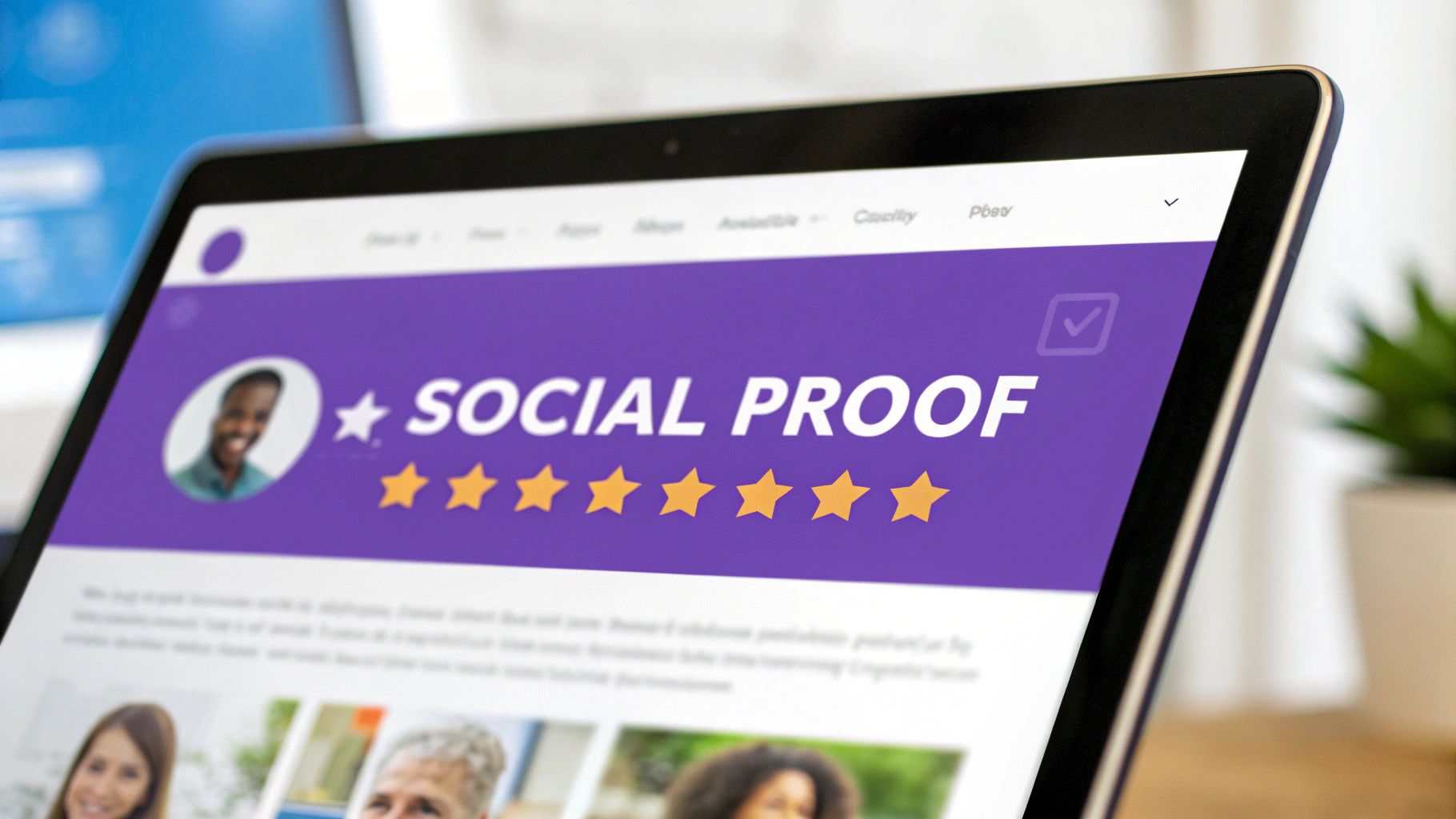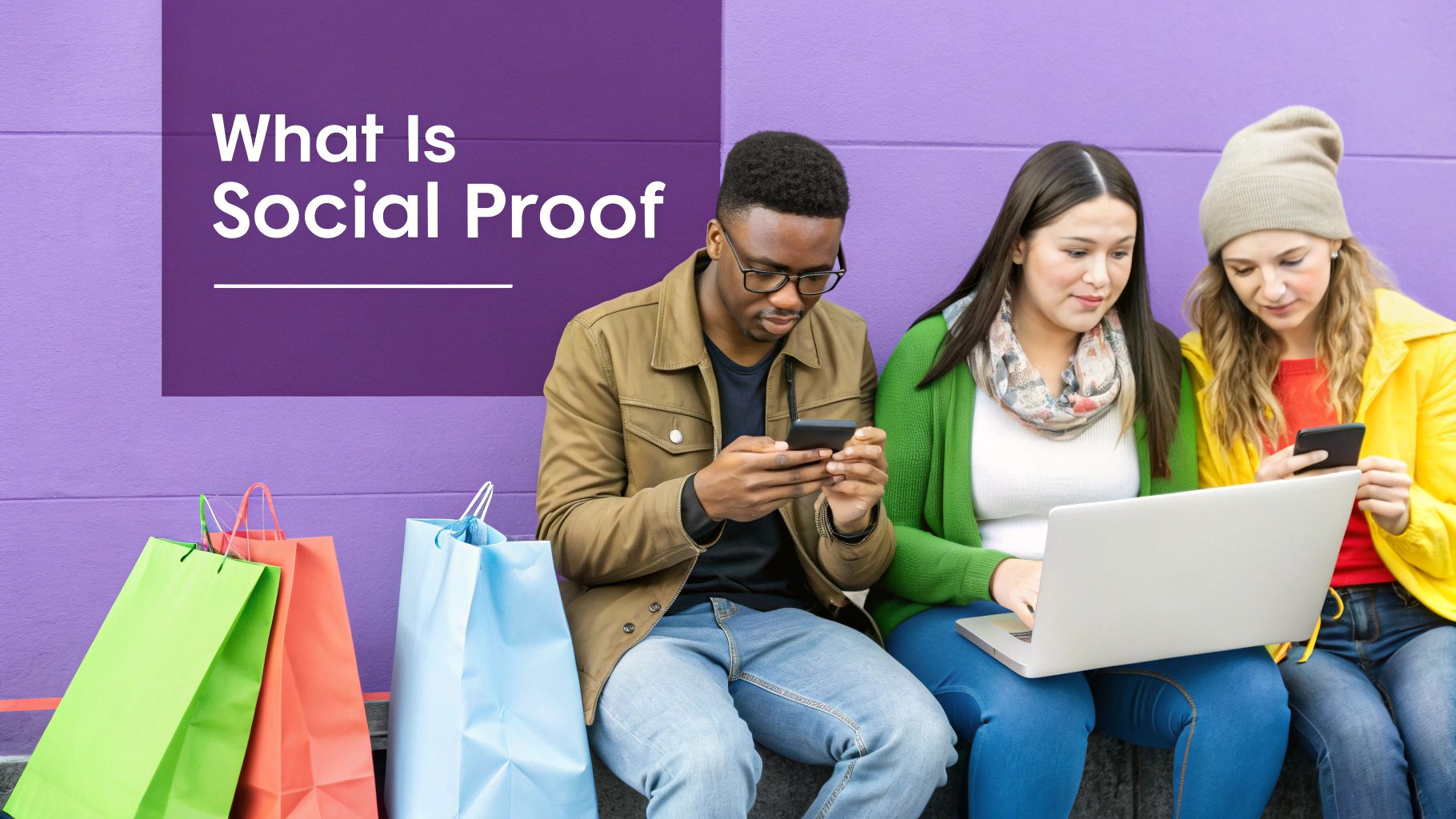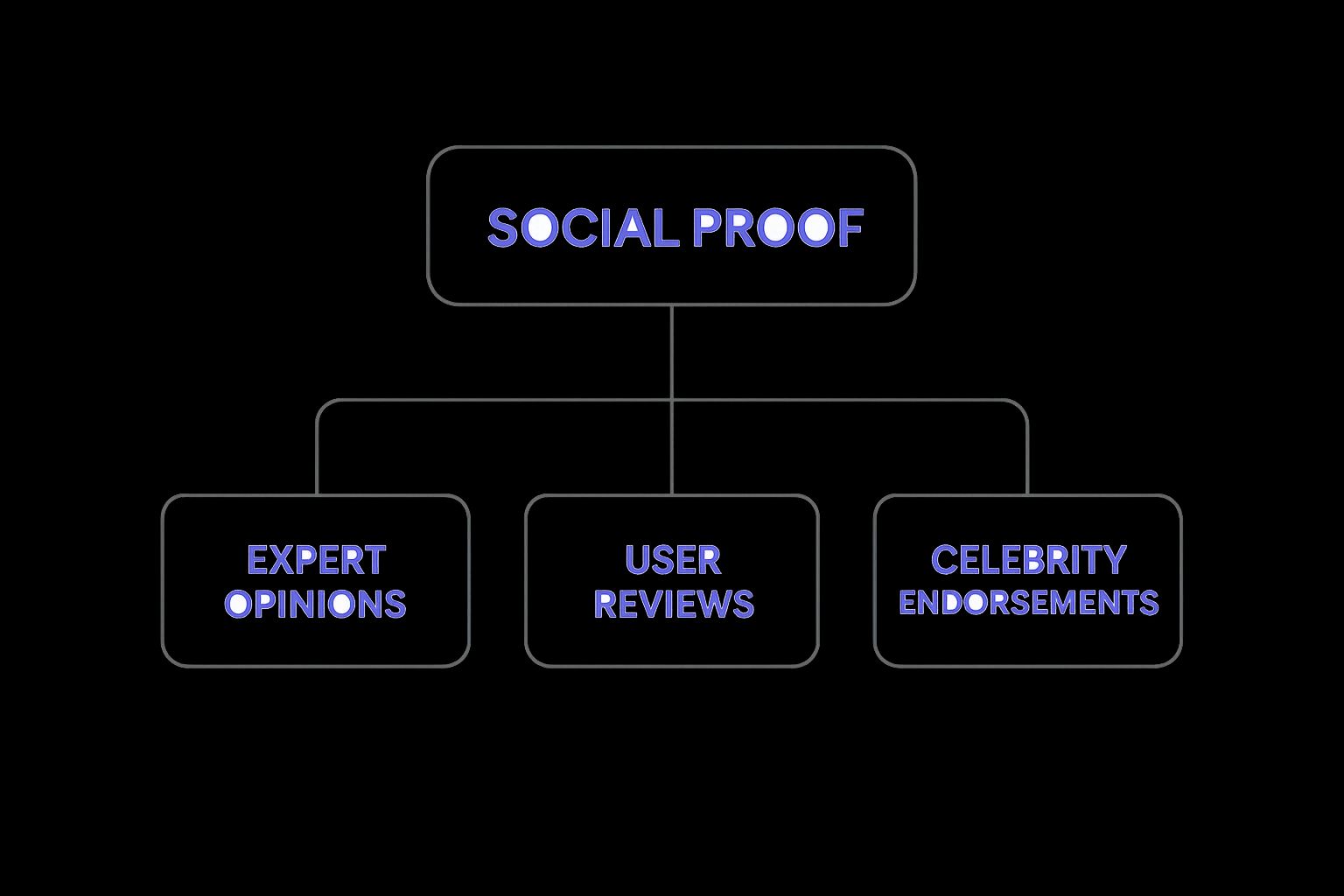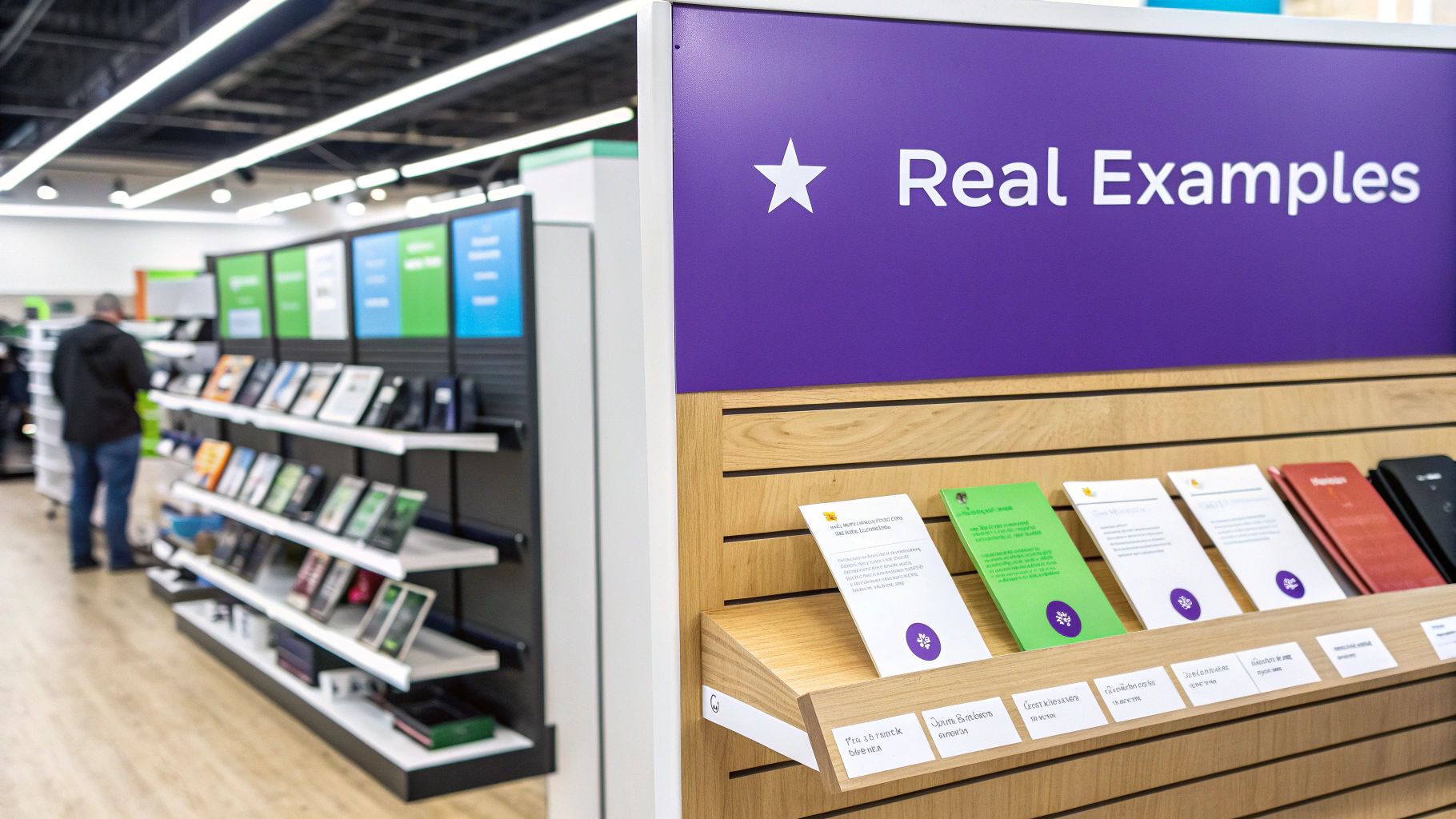What is Social Proof in Marketing? Boost Conversions Now

Ever walked past two restaurants, one bustling with people and the other completely empty? Which one do you instinctively trust more? The busy one, right? That gut feeling is social proof in action.
In marketing, it’s the same idea. Social proof is a powerful psychological shortcut. When potential customers see that lots of other people are already buying and loving a product, they assume it must be a good choice. It's not about what a brand says about itself; it's about what others say.
Understanding Social Proof And Why It Matters

At its heart, social proof is about building immediate trust by showing, not just telling. It replaces a company's own marketing claims with authentic evidence from real people—and that feels far more genuine. By highlighting things like customer reviews, user photos, or expert endorsements, you tap into our natural human tendency to follow the crowd.
This simple shift does wonders for reducing purchase anxiety. When someone sees that hundreds of others have already taken the leap and are happy with their decision, they feel much more confident. It’s a powerful confirmation that they aren't taking a blind risk.
The Core Idea of Social Proof Explained
To really grasp how social proof works, it helps to break it down into its two main parts: the psychological trigger that drives our behavior and how marketers apply that principle.
| Psychological Principle | Marketing Application |
|---|---|
| Informational Social Influence: When we're unsure how to act, we look to others for clues, assuming they know something we don't. | Customer Reviews & Ratings: Displaying positive reviews and high star ratings to show that other buyers have already vetted the product and found it valuable. |
| Conformity: Our deep-seated desire to fit in and be accepted by a group makes us more likely to follow the actions of the majority. | "Bestseller" & "Most Popular" Labels: Highlighting popular products to signal that a majority of customers have chosen and approved of them, encouraging new buyers to do the same. |
This table shows how a basic human instinct becomes a powerful tool for building credibility and driving sales in a business context.
The Impact On Consumer Behavior
The influence social proof has on buying decisions is massive and easy to measure. Think about the "stealth shopping" trend, where customers do all their research online without ever talking to a salesperson. In these quiet moments, strong social proof can be the one thing that grabs their attention and builds trust before they even think about your pricing.
The numbers don't lie. Research shows that 63% of consumers are more likely to buy from a site that has customer ratings and reviews. It’s clear that peer validation is no longer a "nice-to-have"—it's essential. On top of that, 76% of marketers report that using social proof significantly boosts their conversion rates, effectively turning hesitant visitors into confident buyers.
Building Trust Through Authenticity
For today's businesses, especially for entrepreneurs trying to build a brand from the ground up, social proof isn't just a marketing tactic. It's a foundational piece of your strategy. It’s all about letting your happiest customers become your most persuasive salespeople.
Social proof works because it leverages a core human behavior: when uncertain, we look to others for guidance on how to act. This creates a feedback loop of trust and validation that is hard to achieve with traditional advertising.
This is especially true online, where authentic connections are everything. If you're looking to grow your brand, mastering these principles is non-negotiable. For a deeper dive, check out our guide on social media for entrepreneurs to see how you can put these strategies to work.
The Five Essential Types of Social Proof
Knowing what social proof is in marketing is a great start, but the real magic happens when you know which type to pull out of your back pocket. Social proof isn't a one-size-fits-all tactic; it’s more like a versatile toolkit. Each tool resonates differently depending on your audience and what you're trying to achieve, so picking the right one is crucial.
The infographic below breaks down some of the core categories that anchor most social proof strategies.

It’s a simple way to see how different forms of validation—whether from experts, friends, or famous faces—all work together to build that all-important trust. Let's dive into five of the most powerful types you can start using today.
1. Customer Reviews and Ratings
This is probably the first thing that comes to mind when you hear "social proof." Think about the star ratings on Amazon or the detailed feedback on a local restaurant's Yelp page. These everyday evaluations from regular people are incredibly powerful because they feel raw, real, and completely unbiased.
And the data doesn't lie. Online reviews are now a cornerstone of consumer trust. A whopping 88% of consumers trust online reviews just as much as personal recommendations, and simply showing them can boost conversion rates by an incredible 34%. For a deeper look at the numbers, you can explore more insights about social proof statistics.
2. User-Generated Content (UGC)
User-generated content (UGC) takes reviews to a whole new level. Instead of just reading about an experience, potential customers get to see it. UGC is all the photos, videos, social media posts, and blog articles created by your actual customers, showing off your product in their real lives.
This kind of proof feels incredibly authentic because it isn't polished or scripted by a marketing team. It’s just real people in real situations, getting real results. When brands encourage customers to share their experiences with a special hashtag, they're building a self-sustaining engine of community and trust.
A customer's unboxing video or a photo of them using your product in a creative way often says more than a perfectly crafted advertisement ever could. It’s validation in its most authentic form.
3. In-Depth Testimonials
While reviews are quick hits of feedback, testimonials are the deeper, more curated stories of a customer's journey. They move past a simple "this product is great" and dig into the specific problem a customer was facing, how your product delivered the solution, and the positive outcome they achieved.
The most effective testimonials usually include:
- A clear before-and-after story: This structure makes the value you offer tangible and easy to grasp.
- Specific, measurable results: "It helped me save 10 hours a week" is far more compelling than vague praise.
- A photo and name of the customer: Putting a real face and name to the story instantly boosts its credibility.
4. Expert and Influencer Endorsements
This type of social proof works by borrowing credibility from a trusted source. When an industry expert, a well-regarded publication, or a popular influencer gives your product their seal of approval, their authority and trust are transferred to your brand.
Think about it. A skincare brand featured in a dermatology journal or a new software tool praised by a famous tech blogger can easily win over skeptical buyers. An expert’s stamp of approval signals quality, reliability, and that you’re a serious player in your field.
5. Data-Backed Case Studies
For B2B companies or products with a high price tag, case studies are the ultimate form of social proof. They are detailed, data-heavy accounts of how a specific client used your product or service to get measurable results.
Unlike testimonials, which appeal to emotion, case studies speak directly to analytical decision-makers who need to see the hard evidence. They focus on metrics, ROI, and cold, hard facts to justify the investment.
Real-World Examples of Social Proof in Action

This screenshot from Amazon is a masterclass in social proof. It’s not just one thing; it’s a powerful combination of star ratings, the sheer number of reviews, and those coveted "bestseller" labels, all packed onto a single product page. For a shopper, this combo instantly signals that a product is not just popular but also well-liked by thousands of people, which goes a long way in melting away any buying hesitation.
Theory is great, but the real magic happens when you see how top-tier brands weave social proof into their customer experience. They don’t just slap on a testimonial and call it a day. They build entire systems that constantly generate and display this proof, making it a natural, organic part of the buying journey. Let's break down their methods to see what we can learn.
Amazon: The King of Customer Reviews
Amazon’s empire is built on a simple yet incredibly powerful feedback loop: customer reviews. The platform makes it almost frictionless for buyers to leave a star rating or a detailed review, creating a massive, ever-growing library of peer-to-peer validation.
But they don’t stop there. Think about features like "Customers also bought" or "Frequently bought together." These are subtle yet brilliant forms of social proof. They tap directly into our instinct to follow the herd, whispering, "Hey, if all these other smart shoppers are buying these items together, it’s probably a good move for you, too."
Slack: The Credibility Wall of Logos
For B2B and SaaS companies, establishing trust and authority from the get-go is everything. Slack nails this with its iconic "wall of logos." When a potential customer lands on their site and sees logos from giants like Airbnb, it sends an immediate, powerful message: Slack is a trusted, enterprise-ready solution.
This visual shorthand does all the heavy lifting of building credibility. It basically says, "If these incredibly successful companies trust us with their business, you can too." It’s a classic and highly effective way to borrow authority and create instant legitimacy.
Glossier and User-Generated Authenticity
The direct-to-consumer beauty brand Glossier didn't just find customers; it built a cult-like following by turning them into its most effective marketers. The brand actively encourages users to post photos of themselves using Glossier products on social media, then proudly features this user-generated content (UGC) on its own official channels. If you're looking for ways to get your audience involved, exploring social media content ideas is a great place to start.
This strategy fosters a deep sense of community and, most importantly, authenticity. Instead of seeing a perfectly polished ad, potential buyers see real people, with diverse looks and styles, genuinely celebrating the products.
By putting real customer photos at the center of its marketing, Glossier shows that its products are for everyone, building a relatable and aspirational brand identity simultaneously.
Another powerful form of social proof is referral marketing, which directly leverages word-of-mouth recommendations from happy customers. When exploring how to apply these ideas, examining successful referral marketing campaigns provides excellent insight into how brands reward and encourage this behavior. Each of these real-world examples shows that social proof in marketing isn't just a single tactic but a strategic approach to building trust at every touchpoint.
Tangible Business Benefits of Using Social Proof
So, what's the real payoff of using social proof? It’s not just about chasing popularity—it’s a smart business move with tangible results. Think about it: when someone is on the fence about buying from you, their biggest fear is making a bad decision. Social proof tackles that fear head-on.
Seeing real star ratings, testimonials, and user photos crushes that purchase anxiety. Suddenly, your brand isn't just making claims; it's showing proof. That’s a game-changer.
Build Brand Credibility and Trust
The most immediate win is a massive boost in credibility. Instead of just talking about how great you are, you’re letting happy customers do the talking for you. This builds a kind of authentic trust that slick marketing copy just can't buy.
Social proof shifts the narrative from "what we say about ourselves" to "what our happy customers say about us." This authentic validation is the bedrock of a trustworthy and respected brand.
This is especially powerful with user-generated content (UGC). Research shows that a whopping 75% of marketers find UGC makes their campaigns more authentic and relatable. It just feels more real. If you want to dig deeper into how this works, you can find more findings about social proof marketing and the stats behind it.
Lower Customer Acquisition Costs
When your customers start singing your praises, they effectively become your best marketers. This has a direct, positive impact on your bottom line. All those positive reviews, social shares, and word-of-mouth referrals create a powerful, organic marketing flywheel.
The result? Your customer acquisition cost (CAC) goes down. You're no longer paying to reach every single new customer because your existing, happy customers are doing a lot of the heavy lifting for you.
Enhance Your Online Presence and SEO
Don't overlook the SEO benefits, either. All that authentic user content—reviews, Q&As, testimonials—is packed with fresh, relevant keywords and natural language that search engines love. This keeps your website content dynamic and helps you rank for long-tail search terms you probably weren't even targeting.
As your credibility grows, so does your digital footprint. By weaving these strategies into your marketing, you can enhance your online presence and pull in more organic traffic over the long haul.
How to Implement Social Proof in Your Marketing

Knowing what social proof is gets you in the door, but actually using it is what separates the winners from the rest. The trick is to build a system for gathering and showing off genuine customer feedback without ever feeling pushy. This isn't about a one-time campaign; it’s about creating an engine that builds trust on autopilot.
A fantastic place to start is by automating your review collection. A simple, well-timed email sent a week or so after a customer gets their order works wonders. Keep the ask simple and make it dead easy for them to leave a review—maybe a direct link right to the product page.
Encourage Authentic User-Generated Content
Beyond basic reviews, you want to inspire customers to share their real-life experiences visually. Creating a unique, branded hashtag is a surprisingly powerful way to get a steady stream of user-generated content (UGC).
Plaster that hashtag everywhere: on your packaging, in email signatures, and all over your social media profiles. When customers share photos and videos, you get authentic marketing gold that speaks directly to new buyers. This flow of content isn't just persuasive; it also helps you learn how to create engaging content that genuinely connects.
To make life easier, you can use dedicated testimonial collection platforms to help gather, manage, and display all that great customer feedback.
Strategically Place Social Proof for Maximum Impact
Once you have a collection of reviews, testimonials, and UGC, where you put them is everything. Your goal is to get the right proof in front of the right person at the right moment to quiet their doubts.
Here are a few high-impact spots to consider:
- Homepage: Put your best, most powerful testimonials or a "wall of logos" from big-name clients right on your homepage. It builds instant credibility.
- Product Pages: This is a non-negotiable. Displaying star ratings and individual reviews on product pages helps answer questions and eases that last-minute hesitation.
- Checkout Process: A subtle "Join 10,000+ happy customers" or a short, punchy testimonial near the "buy" button can be the final nudge someone needs.
The most effective implementation of social proof feels natural and helpful, not forced. It should guide the customer's journey by providing reassurance and validation at every critical touchpoint.
By making authenticity your priority and weaving these elements into your site, you can build a powerful social proof engine that fuels both trust and sales.
The Psychology Behind Why Social Proof Sells
To really get what social proof is all about in marketing, you have to pop the hood and look at the human psychology that gives it so much power. It’s effective because it plugs directly into deep-seated instincts we all share—mental shortcuts our brains use to make decisions faster and with less risk.
At its heart, social proof leans on two powerful psychological drivers. The first is what’s known as informational social influence. This is our basic, fundamental need to be correct. When we’re in an uncertain situation—like picking a new software or choosing a restaurant in a city we don't know—we look to others for clues. We just assume they know something we don’t. A crowd gathered at one food truck is a strong signal that it’s probably the better, safer choice.
The Need to Belong
The second driver is normative social influence, and this one comes from our deep-seated desire to fit in and be accepted by the group. We're social creatures, wired to conform to what our peers are doing because it makes us feel like part of a community. This instinct is exactly why products slapped with a "bestseller" label are so tempting.
Choosing the popular option isn’t just about getting a good product; it’s about joining a tribe of people who have already given it their stamp of approval. That sense of belonging eases feelings of isolation and makes the purchase feel like a socially smart move.
Connecting Instincts to Marketing Outcomes
When you understand these psychological triggers, you can start designing marketing that feels more natural and less like a hard sell. Showcasing testimonials, reviews, or user photos isn't just about listing features. You're actually providing answers to the subconscious questions every customer is asking: "Is this the right choice for me?" and "Will this help me fit in?"
Social proof works by bypassing rational debate and speaking directly to our primal instincts for correctness and belonging. It builds trust by showing that others have already walked this path and found it rewarding.
For instance, when you share authentic customer stories on social media, you’re not just showing off your product. You’re building a visible community that other people will naturally want to be a part of. This is a huge piece of building a strong online identity, and you can learn more in our social media branding guide.
When you align your marketing with these fundamental human behaviors, you create campaigns that hit on a much deeper level, building the kind of genuine, lasting trust that truly fuels growth.
Frequently Asked Questions About Social Proof
As you start weaving social proof into your marketing, you'll naturally run into some common questions. Working through these is what separates a good strategy from a great one—the kind that feels effective, authentic, and genuinely helpful.
Let's tackle a few of the most common hurdles marketers face.
How Should You Handle Negative Reviews?
It’s tempting to just hit "delete" on negative feedback and pretend it never happened. Don't do it. That’s a huge mistake.
A few less-than-perfect reviews sprinkled among a sea of positive ones actually make you look more trustworthy. Nobody’s perfect, and a flawless 5.0-star rating can feel a little suspicious. It shows you’re transparent and not just curating a fantasy version of your brand.
The best move? Respond publicly, professionally, and quickly. Thank the customer for their honesty, own up to their bad experience, and offer a real solution. This turns a public negative into a major positive, showing everyone else that you truly stand behind your product and care about your customers.
Can You Have Too Much Social Proof?
Absolutely. While social proof is a powerful tool, it’s easy to go overboard.
When you flood your site with a constant barrage of pop-ups, testimonials, and review snippets, it stops feeling helpful and starts feeling overwhelming. It creates a frantic, high-pressure vibe that can seriously damage the user experience.
The goal is to provide gentle reassurance, not to create a sense of digital chaos. Your social proof should feel like a helpful guide, subtly validating a customer's decision-making process at key moments.
It's all about finding the right balance. Place your social proof elements strategically where they add the most value—like on a product page or right before checkout—instead of plastering them on every corner of your site.
What Works for a New Business with Few Customers?
This is the classic chicken-and-egg problem. If you don't have a big customer base to pull from yet, you have to get a little creative.
Instead of focusing on sheer numbers, prioritize other forms of validation. Here’s where to start:
- Expert Endorsements: Find a respected voice in your industry. Get them to try your product and give you a quote. Their credibility can give your brand an instant boost.
- Early-Adopter Testimonials: Go deep with your first few customers. A single, powerful story about how your product solved their problem is often more persuasive than a dozen generic star ratings.
- Offer Incentives: It's okay to nudge things along. Offer a small discount or a freebie to your first customers in exchange for an honest review. This is a great way to kickstart your collection of valuable social proof.
Ready to build an undeniable online presence? With MakerBox, you can transform your professional profiles in just 30 seconds, using AI trained on the world's top performers. Elevate your career or business now.





